|
Shenandoah National Park straddles the Blue Ridge, a unique line of mountains forming the easternmost rampart of the great Appalachian Range. The story of Shenandoah’s mountains is the story of two mountain ranges, spanning over one billion years of earth’s history. Between 1.2 and 1.0 billion years ago, ancient collisions of tectonic plates raised a great mountain range, named Grenville by geologists. This process, very similar to the forces creating the Himalayas today, produced incredible heat and pressure that melted and deformed the rocks deep in the mountains’ core. These highly metamorphosed rocks are preserved within Shenandoah today and provide geologists a way to date the timing of these events. When pressures from these collisions eased, the peaks stopped rising, and erosion took over. For hundreds of millions of years, the once-lofty Grenville range slowly wore away, until it was no more than a landscape of rolling hills and occasional higher points, similar to the Virginia Piedmont found east of Shenandoah today. Evidence of this past terrain can still be seen in the shape of contacts between the old Grenville rocks and the younger rocks above. During this period primitive life was just beginning to flourish in oceans. Around 570 million years ago this stable scene ended violently as the underlying tectonic plates began to move apart. Vast quantities of lava rose through a developing system of rifts, erupting onto the surface along rift zones that stretched for thousands of miles along what is now eastern North America. For several million years, these lava flows filled in valleys and lapped against hillsides, until finally the rift between the plates grew so wide that water began to fill it, and a new ocean was born. As this ocean, named Iapetus, spread over the land, it left behind thick deposits of sediments that hardened into layered sedimentary rocks. The youngest rocks in Shenandoah are river, lagoon, and beach deposits left behind by the early stages of the Iapetus. In the valleys and ridges to the west, thick sequences of limestone and other marine rocks preserve evidence for the rest of this underwater period. The ancient Grenville rocks, the lava flows, and the sediments represent the three main geologic units found within Shenandoah. All of these events occurred over 400 million years ago and the Appalachian Mountains had yet to appear on the scene! The Appalachian Mountains formed when the tectonic plates originally active during Grenville times reversed themselves and began to collide once more. This great collision between Europe and North Africa on one side and North America on the other closed the Iapetus Ocean and created a massive new mountain range as the thick layers of sediment that once lay miles below water were now thrust up into new summits. These were the Appalachian Mountains. At their peak around 350-300 million years ago, they were likely as large and dramatic as the Himalayas. By 200 million years ago, however, these forces had abated once more, and the Appalachians were eroding away just as their ancestors, the Grenville Mountains, had done. Once again, the plates reversed direction and moved apart, this time forming the beginnings of the Atlantic Ocean. Today, the worn-down roots of the Appalachians lie quietly along the flank of the still-widening Atlantic, waiting for the cycle to start anew. 
Eric Butler - NPS Photo Related Information
Badger, R.L. 1999. Geology along Skyline Drive, a self-guided tour for motorists. Falcon Publishing, Inc. Helena, Montana. Frye, K. 1986. Roadside Geology of Virginia. Mountain Press Publishing Company, Inc.Missoula, Montana. Gaithright II, T.M. 1976. Geology of the Shenandoah National Park, Bulletin 86. Virginia Division of Mineral Resources, Charlottesville, Virginia. Harris, A.G. and E. Tuttle. 1990. Geology of National Parks. Kendall/Hunt Publishing Company, Dubuque, Iowa. Harris, D.V. 1976. The Geologic Story of the National Parks and Monuments. Colorado State University Foundation Press, Fort Collins, Colorado. Skinner, B.J. and S.C. Porter. 1992. The Dynamic Earth: An Introduction to Physical Geology. John Wiley & Sons, Inc. Websites that provide helpful information about geology are: U.S. Geological Science in Our National Parks
|
Last updated: October 26, 2023
